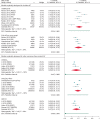Prediction models for atrial fibrillation applicable in the community: a systematic review and meta-analysis
- PMID: 32011689
- PMCID: PMC7526764
- DOI: 10.1093/europace/euaa005
Prediction models for atrial fibrillation applicable in the community: a systematic review and meta-analysis
Abstract
Aims: Atrial fibrillation (AF) is a common arrhythmia associated with an increased stroke risk. The use of multivariable prediction models could result in more efficient primary AF screening by selecting at-risk individuals. We aimed to determine which model may be best suitable for increasing efficiency of future primary AF screening efforts.
Methods and results: We performed a systematic review on multivariable models derived, validated, and/or augmented for AF prediction in community cohorts using Pubmed, Embase, and CINAHL (Cumulative Index to Nursing and Allied Health Literature) through 1 August 2019. We performed meta-analysis of model discrimination with the summary C-statistic as the primary expression of associations using a random effects model. In case of high heterogeneity, we calculated a 95% prediction interval. We used the CHARMS (Critical Appraisal and Data Extraction for Systematic Reviews of Prediction Modelling Studies) checklist for risk of bias assessment. We included 27 studies with a total of 2 978 659 unique participants among 20 cohorts with mean age ranging from 42 to 76 years. We identified 21 risk models used for incident AF risk in community cohorts. Three models showed significant summary discrimination despite high heterogeneity: CHARGE-AF (Cohorts for Heart and Aging Research in Genomic Epidemiology) [summary C-statistic 0.71; 95% confidence interval (95% CI) 0.66-0.76], FHS-AF (Framingham Heart Study risk score for AF) (summary C-statistic 0.70; 95% CI 0.64-0.76), and CHA2DS2-VASc (summary C-statistic 0.69; 95% CI 0.64-0.74). Of these, CHARGE-AF and FHS-AF had originally been derived for AF incidence prediction. Only CHARGE-AF, which comprises easily obtainable measurements and medical history elements, showed significant summary discrimination among cohorts that had applied a uniform (5-year) risk prediction window.
Conclusion: CHARGE-AF appeared most suitable for primary screening purposes in terms of performance and applicability in older community cohorts of predominantly European descent.
Keywords: Atrial fibrillation; Community; Meta-analysis; Risk model; Screening; Systematic review.
Published on behalf of the European Society of Cardiology. All rights reserved. © The Author(s) 2020. For permissions, please email: journals.permissions@oup.com.
Figures




References
-
- Chugh SS, Roth GA, Gillum RF, Mensah GA.. Global burden of atrial fibrillation in developed and developing nations. Glob Heart 2014;9:113–9. - PubMed
-
- Magnussen C, Niiranen TJ, Ojeda FM, Gianfagna F, Blankenberg S, Njolstad I. et al. Sex differences and similarities in atrial fibrillation epidemiology, risk factors, and mortality in community cohorts: results from the BiomarCaRE Consortium (Biomarker for Cardiovascular Risk Assessment in Europe). Circulation 2017;136:1588–97. - PMC - PubMed
-
- Wolf PA, Abbott RD, Kannel WB.. Atrial fibrillation as an independent risk factor for stroke: the Framingham Study. Stroke 1991;22:983–8. - PubMed
-
- Kirchhof P, Benussi S, Kotecha D, Ahlsson A, Atar D, Casadei B. et al. 2016 ESC Guidelines for the management of atrial fibrillation developed in collaboration with EACTS. Europace 2016;18:1609–78. - PubMed
Publication types
MeSH terms
LinkOut - more resources
Full Text Sources
Medical

